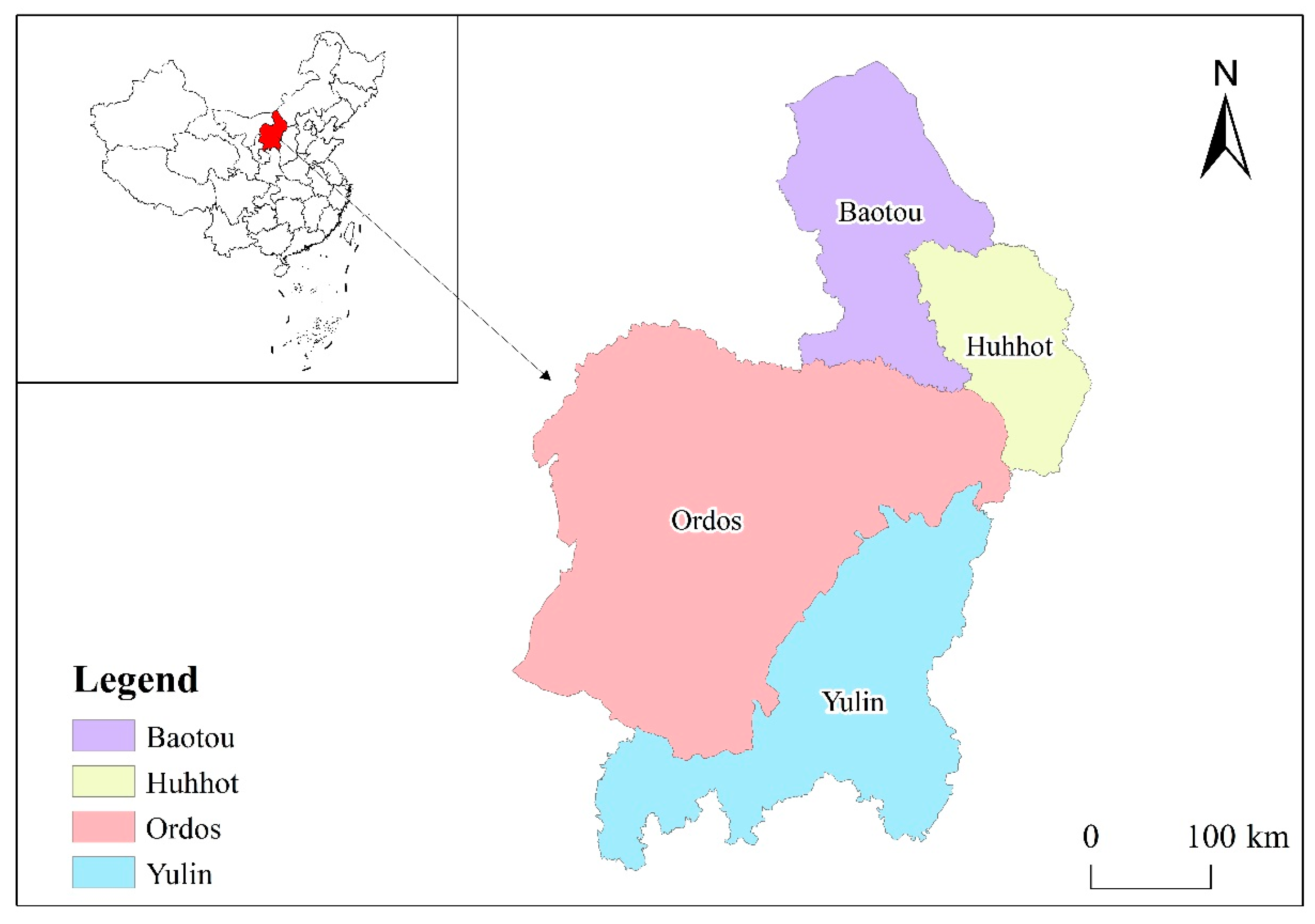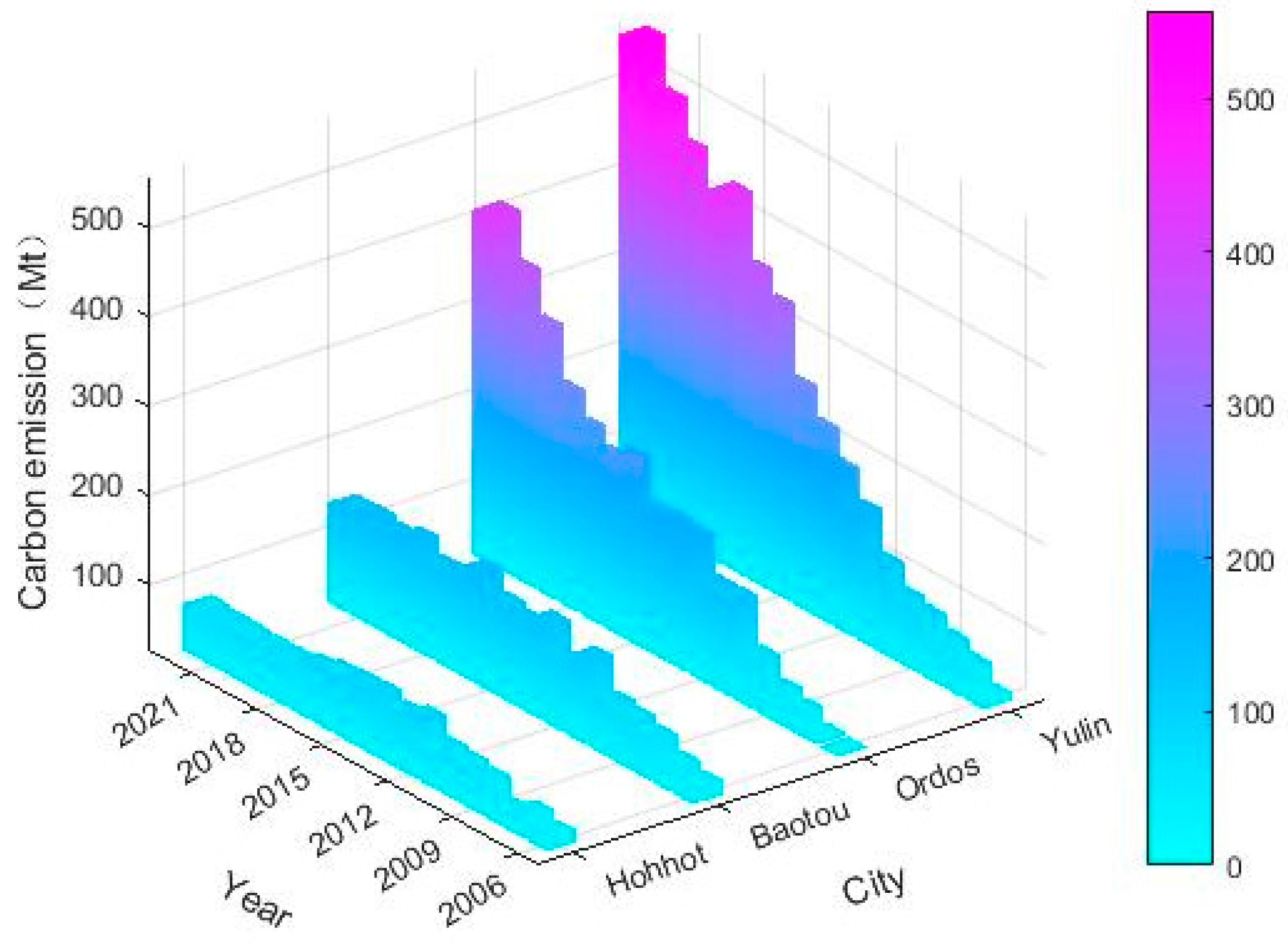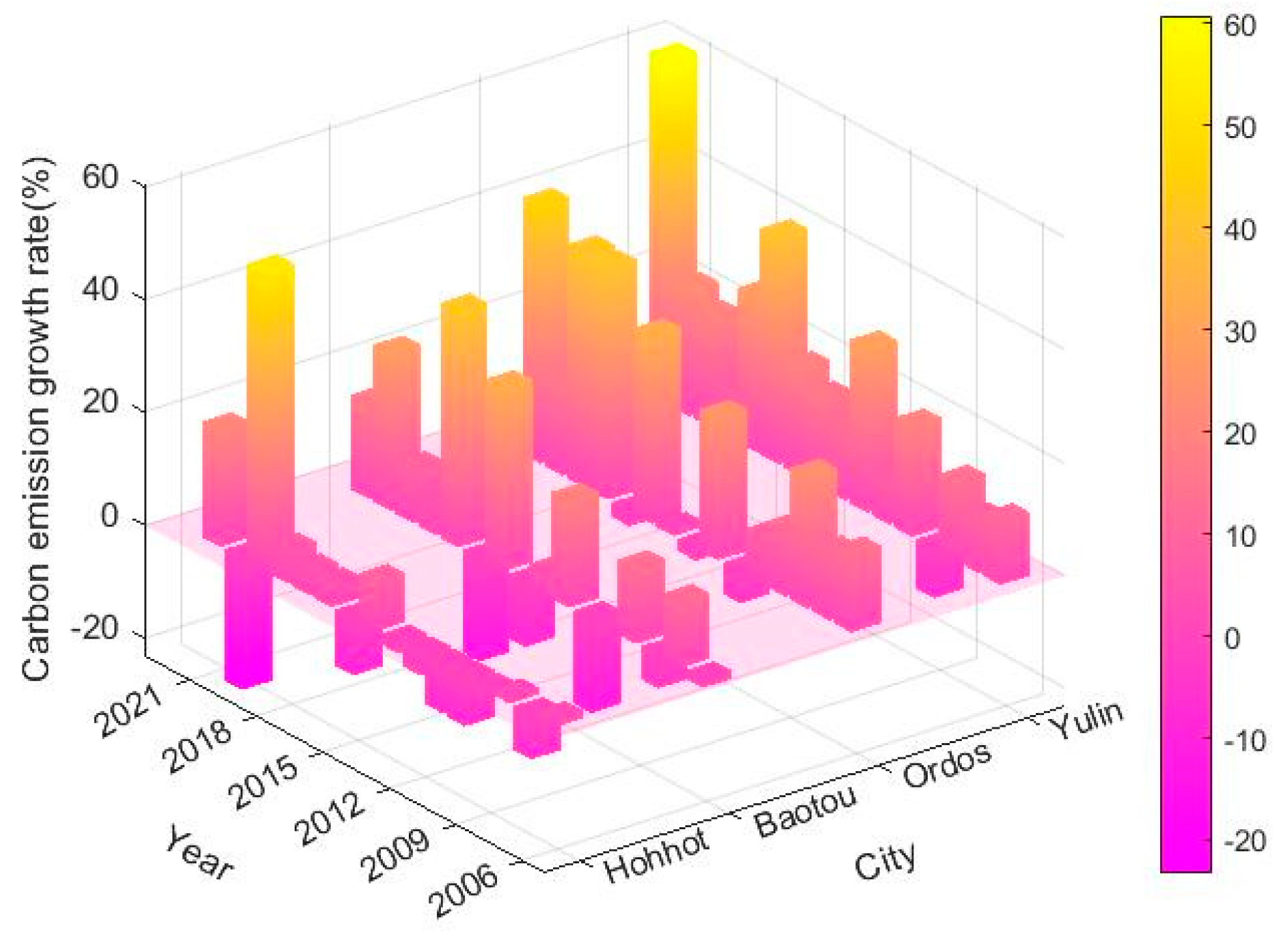Analysis of the Characteristics and Driving Mechanisms of Carbon Emission Decoupling in the Hu-Bao-O-Yu City Cluster under the “Double Carbon” Target
Abstract
:1. Introduction
2. Materials and Methods
2.1. Study Area
2.2. Data Sources
2.3. Research Methodology
2.3.1. Economic Contribution of Carbon Emissions
2.3.2. Tapio Decoupling Model
2.3.3. GDMI Method
2.3.4. GDIM-Based Decoupling Index Modelling
3. Results and Analysis
3.1. Carbon Emission Accounting Results
3.1.1. Total Carbon Emissions Change
3.1.2. Carbon Emissions Change Rate Profile
3.1.3. Changes in the Economic Contribution of Carbon Emissions
3.2. Decoupling Analysis
3.2.1. Analysis of the Decoupling Effect of Carbon Emissions
3.2.2. Trends in Decoupling Indicators
4. Further Discussion
5. Conclusions and Policy Suggestions
5.1. Conclusions
- (1)
- Hu-Bao-O-Yu City cluster, Ordos City, Baotou City, and Yulin City all have significant rising carbon emissions every year. The most important carbon source in the Hu-Bao-O-Yu City cluster is Yulin City, which has the highest annual carbon emissions. Huhhot City, on the other hand, has the lowest annual carbon emissions, with a general trend of rising and then falling.
- (2)
- The yearly growth rate of carbon emissions in the urban area is going down, and this is a bigger trend. Yulin, Ordos, Baotou, and Huhhot had the slowest average growth rates in carbon emissions from 2005 to 2021. Huhhot has become more energy-dependent in recent years.
- (3)
- Out of all the cities in this group, Yulin has the highest economic contribution efficiency of carbon emissions. Ordos has stayed pretty stable, while Huhhot and Baotou have paid attention to economic growth in recent years and have raised their economic contribution efficiency to carbon emissions.
- (4)
- Hohhot, Baotou, and Ordos are all part of a city cluster that is decoupling. Hohhot and Baotou are expansionary negative decoupling, while Yulin is strong negative decoupling. In the last few years, decoupling has become better in all towns and the city cluster. However, strong decoupling happens less often, and economic growth is still linked to carbon pollution.
5.2. Policy Suggestions
Author Contributions
Funding
Institutional Review Board Statement
Informed Consent Statement
Data Availability Statement
Acknowledgments
Conflicts of Interest
References
- He, C.; Wang, Y.P.; Tang, K. Impact of Low-Carbon City Construction Policy on Green Innovation Performance in China. Emerg. Mark. Financ. Trade 2023, 59, 15–26. [Google Scholar] [CrossRef]
- He, H.; Kramer, R.J.; Soden, B.J.; Jeevanjee, N. State Dependence of CO2 Forcing and Its Implications for Climate Sensitivity. Science 2023, 382, 1051–1056. [Google Scholar] [CrossRef] [PubMed]
- Zhao, X.; Xu, H.; Sun, Q. Research on China’s Carbon Emission Efficiency and Its Regional Differences. Sustainability 2022, 14, 9731. [Google Scholar] [CrossRef]
- Hao, J.; Gao, F.; Fang, X.; Nong, X.; Zhang, Y.; Hong, F. Multi-Factor Decomposition and Multi-Scenario Prediction Decoupling Analysis of China’s Carbon Emission Under Dual Carbon Goal. Sci. Total Environ. 2022, 841, 156788. [Google Scholar] [CrossRef]
- Wang, X.; Wang, G.; Chen, T.; Zeng, Z.; Heng, C.K. Low-carbon city and its future research trends: A bibliometric analysis and systematic review. Sustain. Cities Soc. 2023, 90, 104381. [Google Scholar] [CrossRef]
- Fang, G.; Wang, L.; Gao, Z.; Chen, J.; Tian, L. How to Advance China’s Carbon Emission peak?—A Comparative Analysis of Energy Transition in China and the USA. Environ. Sci. Pollut. Res. 2022, 29, 71487–71501. [Google Scholar] [CrossRef]
- Zeng, C.; Jiang, S.; Zhou, F. Can Low-Carbon City Pilot Policy Promote Regional Green High-Quality Development? Sustainability 2024, 16, 5520. [Google Scholar] [CrossRef]
- Liu, J.; Yang, Q.; Ou, S.; Liu, J. Factor decomposition and the decoupling effect of carbon emissions in China’s manufacturing high emission subsectors. Energy 2022, 248, 123568. [Google Scholar] [CrossRef]
- Chen, J.; Xu, C.; Song, M. Determinants for Decoupling Economic Growth from Carbon Dioxide Emissions in China. Reg. Environ. Change 2020, 20, 1–12. [Google Scholar] [CrossRef]
- Jiang, X.; Su, M.; Li, R. Investigating the factors Influencing the Decoupling of Transport-Related Carbon Emissions from Turnover Volume in China. Sustainability 2018, 10, 3034. [Google Scholar] [CrossRef]
- Zhao, S.; Yin, M. Research on Rural Population Arable Land/Rural Settlements Association Model and Coordinated Development Path: A Case Analysis of the Yellow River Basin (Henan Section). Int. J. Environ. Res. Public Health 2023, 20, 3833. [Google Scholar] [CrossRef]
- Lai, W.; Hu, Q.; Zhou, Q. Decomposition Analysis of PM2.5 Emissions Based on LMDI and Tapio Decoupling Model: Study of Hunan and Guangdong. Environ. Sci. Pollut. Res. 2021, 28, 43443–43458. [Google Scholar] [CrossRef]
- Liu, X.; Zhong, S.; Yang, M. Study on the Decoupling Relationship of Energy-Related CO2 Emissions and Economic Growth in China: Using the New Two-Dimensional Decoupling Model. Ecol. Indic. 2022, 143, 109405. [Google Scholar] [CrossRef]
- Li, L.; Li, Y. The Spatial Relationship Between CO2 Emissions and Economic Growth in the Construction Industry: Based on the Tapio Decoupling Model and STIRPAT Model. Sustainability 2022, 15, 528. [Google Scholar] [CrossRef]
- Wu, Y.; Zhu, Q.; Zhu, B. Decoupling Analysis of World Economic Growth and CO2 Emissions: A Study Comparing Developed and Developing Countries. J. Clean. Prod. 2018, 190, 94–103. [Google Scholar] [CrossRef]
- Chen, J.; Wang, P.; Cui, L.; Huang, S.; Song, M. Decomposition and Decoupling Analysis of CO2 Emissions in OECD. Appl. Energy 2018, 231, 937–950. [Google Scholar] [CrossRef]
- Scofield, J.H.; Doane, J. Energy Performance of LEED-Certified Buildings from 2015 Chicago Benchmarking Data. Energy Build. 2018, 174, 402–413. [Google Scholar] [CrossRef]
- Scipioni, A.; Manzardo, A.; Mazzi, A.; Mastrobuono, M. Monitoring the Carbon Footprint of Products: A Methodological Proposal. J. Clean. Prod. 2012, 36, 94–101. [Google Scholar] [CrossRef]
- Wang, J.; Hui, W.; Liu, L.; Bai, Y.; Du, Y.; Li, J. Estimation and Influencing Factor Analysis of Carbon Emissions from the Entire Production Cycle for Household Consumption: Evidence from the Urban Communities in Beijing, China. Front. Environ. Sci. 2022, 10, 843920. [Google Scholar] [CrossRef]
- du Plessis, M.; van Eeden, J.; Goedhals-Gerber, L. Carbon Mapping Frameworks for the Distribution of Fresh Fruit: A Systematic Review. Glob. Food Secur. 2022, 32, 100607. [Google Scholar] [CrossRef]
- Heimburger, A.M.; Harvey, R.M.; Shepson, P.B.; Stirm, B.H.; Gore, C.; Turnbull, J.; Cambaliza, M.O.; Salmon, O.E.; Kerlo, A.E.; Lavoie, T.N.; et al. Assessing the Optimized Precision of the Aircraft Mass Balance Method for Measurement of Urban Greenhouse Gas Emission Rates Through Averaging. Elem. Sci. Anth. 2017, 5, 26. [Google Scholar] [CrossRef]
- Straatman, B.; Boyd, B.; Mangalagiu, D.; Rathje, P.; Eriksen, C.; Madsen, B.; Stefaniak, I.; Jensen, M.; Rasmussen, S. A Consumption-Based, Regional Input-Output Analysis of Greenhouse Gas Emissions and the Carbon Regional Index. Int. J. Environ. Technol. Manag. 2018, 21, 1–36. [Google Scholar] [CrossRef]
- Long, Y.; Yoshida, Y.; Liu, Q.; Zhang, H.; Wang, S.; Fang, K. Comparison of City-Level Carbon Footprint Evaluation by Applying Single-and Multi-Regional Input-Output Tables. J. Environ. Manag. 2020, 260, 110108. [Google Scholar] [CrossRef] [PubMed]
- Qiang, W.; Min, S. Drivers of decoupling economic growth from carbon emission—An empirical analysis of 192 countries using decoupling model and decomposition method. Environ. Impact Assess. Rev. 2020, 81, 106356. [Google Scholar]
- Abraham Mahanga Tsoni, C.G.; Massonini Ngoma, R.G.T.; Meng, X. Innovation and Climate Change Mitigation Technology in the Asian and African Mining Sector: Empirical Analysis Using the LMDI Method. Energies 2022, 15, 9424. [Google Scholar] [CrossRef]
- Peng, D.; Liu, H. Measurement and Driving Factors of Carbon Emissions from Coal Consumption in China Based on the Kaya-LMDI Model. Energies 2022, 16, 439. [Google Scholar] [CrossRef]
- Luo, X.; Liu, C.; Zhao, H. Driving Factors and Emission Reduction Scenarios Analysis of CO2 Emissions in Guangdong-Hong Kong-Macao Greater Bay Area and Surrounding Cities Based on LMDI and System Dynamics. Sci. Total Environ. 2023, 870, 161966. [Google Scholar] [CrossRef] [PubMed]
- Zou, X.; Li, J.; Zhang, Q. CO2 Emissions in China’s Power Industry by Using the LMDI Method. Environ. Sci. Pollut. Res. 2023, 30, 31332–31347. [Google Scholar] [CrossRef]
- Zhai, J.; Leclaire, N.; Bendewald, M. Deep energy retrofit of commercial buildings: A key pathway toward low-carbon cities. Carbon Manag. 2011, 2, 425–430. [Google Scholar] [CrossRef]
- Zheng, W.; Shen, G.Q.; Wang, H.; Hong, J.; Li, Z. Decision support for sustainable urban renewal: A multi-scale model. Land Use Policy 2017, 69, 361–371. [Google Scholar] [CrossRef]
- Vaninsky, A. Factorial Decomposition of CO2 Emissions: A Generalized Divisia Index Approach. Energy Econ. 2014, 45, 389–400. [Google Scholar] [CrossRef]
- Wang, Y.; Xie, T.; Yang, S. Carbon emission and its decoupling research of transportation in Jiangsu Province. J. Clean. Prod. 2017, 142, 907–914. [Google Scholar] [CrossRef]
- Liu, F.; Kang, Y.; Guo, K. Is electricity consumption of Chinese countiesdecoupled from carbon emissions? A study based on Tapio decoupling index. Energy 2022, 251, 123879. [Google Scholar] [CrossRef]
- Ma, Y.; Meng, S.; Yan, R. Heterogeneity Analysis on Decoupling Factor between Carbon Emissions and GDP in BRICS Countries. Int. J. Digit. Content Technol. Its Appl. 2013, 7, 834. [Google Scholar]
- Jia, Q.; Jiao, L.; Lian, X.; Wang, W. Linking Supply-Demand Balance of Ecosystem Services to Identify Ecological Security Patterns in Urban Agglomerations. Sustain. Cities Soc. 2023, 92, 104497. [Google Scholar] [CrossRef]
- Tian, P.; Liu, Y.; Li, J.; Pu, R.; Cao, L.; Zhang, H. Spatiotemporal Patterns of Urban Expansion and Trade-Offs and Synergies Among Ecosystem Services in Urban Agglomerations of China. Ecol. Indic. 2023, 148, 110057. [Google Scholar] [CrossRef]
- Zhang, C.; Dong, X.; Zhang, Z. Spatiotemporal Dynamic Distribution, Regional Differences and Spatial Convergence Mechanisms of Carbon Emission Intensity: Evidence from the Urban Agglomerations in the Yellow River Basin. Int. J. Environ. Res. Public Health 2023, 20, 3529. [Google Scholar] [CrossRef]
- Xu, Z.; Li, C.; Niu, L. Decoupling Relationship Between Land Mixed Use and Carbon Emissions in Hohhot-Baotou-Ordos-Yulin Urban Agglomeration. Environ. Sci. Res. 2022, 35, 299–308. [Google Scholar]
- Shi, Y. Study on the Relationship Between Urbanization and Eco-environment Interaction Stress in Hu-Bao-O-Yu Urban Agglomeration. Inn. Mong. Sci. Technol. Econ. 2020, 2, 20–22. [Google Scholar]
- Wei, L.; Zhou, L.; Sun, D.; Tang, X. The evolution of Spatio-Temporal Pattern and Scenario Simulation of Urban Agglomeration Expansion in the Yellow River Basin: A Case Study in the Hohhot-Baotou-Ordos-Yulin Urban Agglomeration. Geogr. Res. 2022, 41, 1610–1622. [Google Scholar]
- Song, S.; Zhang, J.; Liu, Z.; He, C. Study on the Location Factors of Urban Expansion in the Drylands: A case Study in the Hohhot-Baotou-Ordos-Yulin Urban Agglomeration, China. J. Nat. Resour. 2021, 36, 1021–1035. [Google Scholar] [CrossRef]
- Shi, M. Forecast of China’s Carbon Emissions Under the Background of Carbon Neutrality. Environ. Sci. Pollut. Res. 2022, 29, 43019–43033. [Google Scholar] [CrossRef] [PubMed]
- Sun, L.X.; Wang, M. The Realistic Way to the Decoupling of Carbon Dioxide Emissions from Economic Growth in China’s Service Sector. Emerg. Mark. Financ. Trade 2023, 59, 786–799. [Google Scholar] [CrossRef]
- Shen, T.; Hu, R.; Hu, P.; Tao, Z. Decoupling between Economic Growth and Carbon Emissions: Based on Four Major Regions in China. Int. J. Environ. Res. Public Health 2023, 20, 1496. [Google Scholar] [CrossRef] [PubMed]







| Variable | Meaning |
|---|---|
| Z = CO2 | Carbon emission |
| X1 = GDP | Regional gross domestic product |
| X2 = CO2/GDP | Carbon emissions per unit of GDP of output (carbon intensity of output) |
| X3 = Energy | Fossil energy consumption |
| X4 = CO2/Energy | Carbon emissions per unit of fossil energy consumed (fossil energy mix) |
| X5 = Investment | Investment in fixed assets |
| X6 = CO2/Investment | Carbon emissions per unit of fixed investment assets |
| X7 = GDP/Investment | Gross domestic product per unit of fixed investment assets |
| X8 = Energy/GDP | Fossil energy consumed to produce a unit of GDP (fossil energy consumption intensity) |
| Year | Decoupling Index | Decoupling State |
|---|---|---|
| 2006 | 1.12 | Expansive coupling |
| 2007 | 0.74 | Weak decoupling |
| 2008 | 0.92 | Expansive coupling |
| 2009 | 0.90 | Expansive coupling |
| 2010 | 1.71 | Expansive negative decoupling |
| 2011 | 0.22 | Weak decoupling |
| 2012 | 1.77 | Expansive negative decoupling |
| 2013 | 1.05 | Expansive coupling |
| 2014 | 0.67 | Weak decoupling |
| 2015 | 32.11 | Expansive negative decoupling |
| 2016 | −0.46 | Strong decoupling |
| 2017 | 0.79 | Weak decoupling |
| 2018 | 0.07 | Weak decoupling |
| 2019 | 1.90 | Expansive negative decoupling |
| 2020 | −8.98 | Strong negative decoupling |
| 2021 | 0.44 | Weak decoupling |
| Mean value | 2.19 | Expansive negative decoupling |
| Year | Huhhot | Baotou | ||
|---|---|---|---|---|
| Decoupling Index | Decoupling State | Decoupling Index | Decoupling State | |
| 2006 | 2.20 | Expansive negative decoupling | 1.73 | Expansive negative decoupling |
| 2007 | 2.73 | Recessive decoupling | 1.51 | Expansive negative decoupling |
| 2008 | 3.12 | Expansive negative decoupling | 0.51 | Weak decoupling |
| 2009 | 3.42 | Expansive negative decoupling | 0.52 | Weak decoupling |
| 2010 | 3.86 | Expansive negative decoupling | 7.15 | Expansive negative decoupling |
| 2011 | 4.41 | Expansive negative decoupling | −1.12 | Strong decoupling |
| 2012 | 4.89 | Recessive decoupling | 4.05 | Expansive negative decoupling |
| 2013 | 5.20 | Expansive negative decoupling | −1.87 | Strong decoupling |
| 2014 | 5.69 | Recessive decoupling | 0.91 | Expansive coupling |
| 2015 | 6.00 | Recessive decoupling | 4.29 | Expansive negative decoupling |
| 2016 | 6.59 | Recessive decoupling | −2.48 | Strong decoupling |
| 2017 | 6.89 | Recessive decoupling | −0.01 | Strong decoupling |
| 2018 | 7.36 | Recessive decoupling | 1.39 | Expansive negative decoupling |
| 2019 | 7.77 | Expansive negative decoupling | −0.72 | Strong decoupling |
| 2020 | 8.24 | Recessive decoupling | 4.67 | Expansive negative decoupling |
| 2021 | 8.16 | Expansive negative decoupling | −0.07 | Strong decoupling |
| Mean value | 5.41 | Expansive negative decoupling | 1.28 | Expansive negative decoupling |
| Year | Ordos | Yulin | ||
| Decoupling Index | Decoupling State | Decoupling Index | Decoupling State | |
| 2006 | 0.37 | Weak decoupling | 1.15 | Expansive coupling |
| 2007 | 1.53 | Expansive negative decoupling | 1.32 | Expansive negative decoupling |
| 2008 | 0.62 | Weak decoupling | 0.38 | Weak decoupling |
| 2009 | 3.06 | Expansive negative decoupling | 0.28 | Weak decoupling |
| 2010 | 1.94 | Expansive negative decoupling | 0.78 | Weak decoupling |
| 2011 | −0.16 | Strong decoupling | 1.32 | Expansive negative decoupling |
| 2012 | 2.74 | Expansive negative decoupling | 1.15 | Expansive coupling |
| 2013 | 0.15 | Weak decoupling | −3.06 | Strong negative decoupling |
| 2014 | −0.50 | Strong decoupling | 0.89 | Expansive negative decoupling |
| 2015 | 12.73 | Expansive negative decoupling | −2.71 | Strong negative decoupling |
| 2016 | −0.97 | Strong decoupling | 1.21 | Expansive negative decoupling |
| 2017 | 0.95 | Expansive coupling | 0.65 | Weak decoupling |
| 2018 | 1.63 | Expansive negative decoupling | −1.39 | Strong decoupling |
| 2019 | 4.33 | Expansive negative decoupling | 1.92 | Expansive negative decoupling |
| 2020 | −4.23 | Strong negative decoupling | −8.44 | Strong negative decoupling |
| 2021 | 0.52 | Weak decoupling | 0.44 | Weak decoupling |
| Mean value | 1.55 | Expansive negative decoupling | −0.26 | Strong negative decoupling |
| Index | 2006–2021 | 2006–2010 | 2011–2015 | 2016–2021 |
|---|---|---|---|---|
| −0.21 | −0.44 | −0.14 | 0.03 | |
| −0.19 | −0.31 | −0.11 | −0.16 | |
| 0.47 | 0.15 | 0.37 | 0.97 | |
| −1.28 | −1.16 | −1.37 | −1.32 | |
| 0.75 | 1.12 | 0.61 | 0.54 | |
| −0.63 | −0.82 | −0.56 | −0.51 |
Disclaimer/Publisher’s Note: The statements, opinions and data contained in all publications are solely those of the individual author(s) and contributor(s) and not of MDPI and/or the editor(s). MDPI and/or the editor(s) disclaim responsibility for any injury to people or property resulting from any ideas, methods, instructions or products referred to in the content. |
© 2024 by the authors. Licensee MDPI, Basel, Switzerland. This article is an open access article distributed under the terms and conditions of the Creative Commons Attribution (CC BY) license (https://creativecommons.org/licenses/by/4.0/).
Share and Cite
Zhou, M.; Yang, J.; Ning, X.; Wu, C.; Zhang, Y. Analysis of the Characteristics and Driving Mechanisms of Carbon Emission Decoupling in the Hu-Bao-O-Yu City Cluster under the “Double Carbon” Target. Sustainability 2024, 16, 7290. https://doi.org/10.3390/su16177290
Zhou M, Yang J, Ning X, Wu C, Zhang Y. Analysis of the Characteristics and Driving Mechanisms of Carbon Emission Decoupling in the Hu-Bao-O-Yu City Cluster under the “Double Carbon” Target. Sustainability. 2024; 16(17):7290. https://doi.org/10.3390/su16177290
Chicago/Turabian StyleZhou, Mengting, Jingran Yang, Xuanwei Ning, Chengliang Wu, and Yang Zhang. 2024. "Analysis of the Characteristics and Driving Mechanisms of Carbon Emission Decoupling in the Hu-Bao-O-Yu City Cluster under the “Double Carbon” Target" Sustainability 16, no. 17: 7290. https://doi.org/10.3390/su16177290






